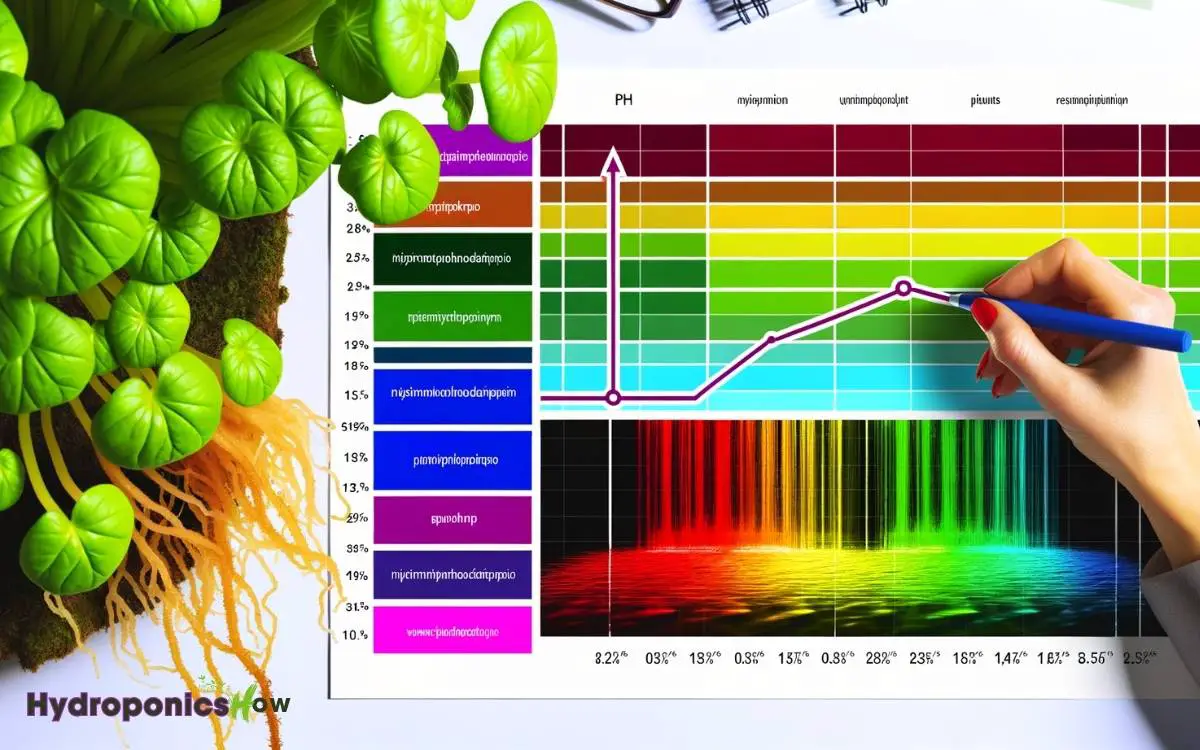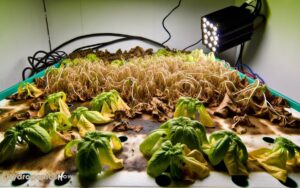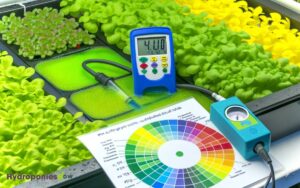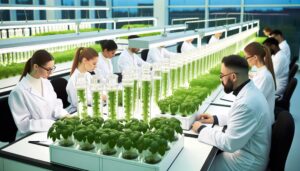5 Key Insights from the Hydroponic pH Chart for Nutrient Absorption in Plants
Maintaining the ideal pH range of 5.5 to 6.5 in hydroponics is vital for efficient nutrient absorption and robust plant growth.
Nutrients are most soluble and accessible within this range. Deviations can lead to nutrient lockout, affecting plant health and yield. Regular monitoring with calibrated pH meters and adjustments using pH adjusters or buffer solutions are essential.
Automated pH controllers can provide real-time management, ensuring stability. Plant-specific pH needs may vary, but most crops thrive within this range. Continue for deeper insights into precise pH management techniques and troubleshooting.

Key Takeaways
Importance of Ph in Hydroponics
In hydroponics, maintaining a vital pH level is essential as it directly influences the solubility and availability of essential nutrients for plant uptake. Ideal pH levels typically range between 5.5 and 6.5, depending on the plant species.
Deviations from this range can result in nutrient lockout, where essential nutrients become insoluble and therefore unavailable to the plant roots.
Studies indicate that micronutrients like iron, manganese, and zinc are more soluble in slightly acidic conditions, while macronutrients such as nitrogen, phosphorus, and potassium are more accessible in a neutral pH environment.
Regular monitoring and adjustment of pH levels using calibrated meters and buffer solutions are necessary to optimize nutrient absorption and ensure robust plant growth.
Nutrient Availability and Ph
Nutrient availability in hydroponic systems is greatly influenced by Ph levels, with ideal Ph ranges typically between 5.5 and 6.5.
Studies indicate that nutrient uptake efficiency decreases outside this range, leading to potential deficiencies or toxicities.
As a result, maintaining an ideal Ph is essential for ensuring balanced nutrient absorption and overall plant health.
Optimal Ph Levels
Achieving the essential pH range, typically between 5.5 and 6.5, is vital for maximizing nutrient availability in hydroponic systems.
Within this range, essential macronutrients like nitrogen, phosphorus, and potassium, as well as micronutrients such as iron, manganese, and zinc, remain soluble and bioavailable.
Deviations outside this range can lead to nutrient lockout, where certain elements become insoluble and therefore inaccessible to plants.
Empirical data suggest that maintaining this pH range optimizes nutrient solubility and uptake, fostering robust plant growth.
Regular pH monitoring and adjustment using appropriate buffering solutions are important for sustaining this ideal range. Ensuring pH stability directly correlates with enhanced yield and better plant health in hydroponic environments.
Nutrient Uptake Efficiency
Maintaining an essential pH range not only prevents nutrient lockout but also greatly enhances nutrient uptake efficiency in hydroponic systems.
Research indicates that the ideal pH range for most hydroponic crops is between 5.5 and 6.5. Within this range, essential nutrients such as nitrogen, phosphorus, and potassium exhibit maximum solubility, facilitating efficient absorption by plant roots.
Deviations from this range can lead to deficiencies or toxicities, impeding plant growth. For instance, iron becomes less available at pH levels above 6.5, while manganese and boron become more soluble at lower pH levels, potentially reaching toxic concentrations.
Therefore, precise pH monitoring and adjustment are essential for optimizing nutrient availability and ensuring robust plant health and productivity in hydroponic systems.
Ph Range for Common Plants
Understanding the ideal pH levels for various plants is essential for maximizing nutrient uptake in hydroponic systems. Maintaining the correct pH range ensures that essential minerals remain available for plant roots, preventing nutrient deficiencies or imbalances. By regularly monitoring and adjusting pH levels, growers can fertilize hydroponic plants easily and promote healthy growth. Consistent pH management also enhances overall plant vigor, leading to higher yields and optimal development.
Most common hydroponic crops, such as lettuce and tomatoes, thrive within a pH range of 5.5 to 6.5.
However, plant-specific pH requirements can vary, necessitating precise adjustments to maintain ideal growth conditions.
Optimal Ph Levels
The ideal pH range for most hydroponically grown plants typically falls between 5.5 and 6.5, as this range maximizes nutrient availability and absorption.
Within this pH window, essential macronutrients such as nitrogen, phosphorus, and potassium are optimally soluble, guaranteeing efficient uptake by plant roots.
Additionally, micronutrients like iron, manganese, and zinc also remain in accessible forms, preventing deficiencies that can impede plant growth.
Key benefits of maintaining ideal pH levels include:
- Enhanced nutrient solubility: Nutrients are more readily available to plants.
- Preventing nutrient lockout: Reduces the risk of nutrients becoming inaccessible.
- Improved root health: Creates an environment conducive to robust root development.
- Optimal plant growth: Ensures overall plant strength and productivity.
Maintaining this pH range is critical for achieving top hydroponic system performance.
Plant-Specific Ph Needs
Different plants have distinctive pH requirements within the ideal 5.5 to 6.5 range, making it imperative to tailor pH levels to specific crops in hydroponic systems.
For example,
- Lettuce (Lactuca sativa) thrives best at a pH of 6.0-6.5, ensuring peak nutrient uptake.
- Tomatoes (Solanum lycopersicum) are slightly more acidic, preferring a pH of 5.5-6.0.
- Strawberries (Fragaria × ananassa) require a pH range of 5.5-6.2 for maximum growth and fruit production.
- Basil (Ocimum basilicum) grows well at a pH of 5.5-6.5.
Tailoring pH to these precise ranges is critical, as deviation can lead to nutrient lockout or toxicity, negatively affecting plant health and yield. Accurate pH monitoring and adjustment are essential for successful hydroponic cultivation.
Adjusting Ph Levels
Accurate adjustment of pH levels is crucial for optimizing nutrient absorption in hydroponic systems.
The ideal pH range for most hydroponic plants is between 5.5 and 6.5, facilitating the maximum uptake of essential nutrients. To achieve this, growers must employ precise techniques and use data-driven approaches.
Key methods for adjusting pH levels include:
- pH Adjusters: Utilize acid (e.g., phosphoric acid) or base (e.g., potassium hydroxide) solutions to correct pH imbalances.
- Buffer Solutions: Implement buffering agents that stabilize pH fluctuations.
- Automated pH Controllers: Deploy digital systems that continuously monitor and adjust pH in real-time.
- Regular Calibration: Ensure pH meters are frequently calibrated for accurate readings.
Implementing these strategies guarantees nutrient availability, promoting robust plant growth.
Monitoring Ph in Hydroponics
Monitoring pH in hydroponics is vital for ensuring ideal nutrient uptake and maintaining plant health. Regularly measuring pH levels allows for the maintenance of the preferred range of 5.5 to 6.5, where nutrient solubility and availability are maximized.
Utilizing precise digital pH meters, calibrated with standard buffer solutions, ensures accurate readings.
Consistent monitoring, ideally daily, helps detect fluctuations that could impair nutrient absorption. Data should be recorded systematically to identify trends and preempt potential issues.
Automated pH control systems can further stabilize pH levels by making fine adjustments in real-time. This proactive approach ensures that plants receive a balanced nutrient solution, promoting robust growth and preventing deficiencies or toxicities.
Troubleshooting Ph Issues
Identifying and addressing pH issues in hydroponics involves analyzing data trends to pinpoint deviations from the ideal range and implementing corrective measures to restore balance.
Effective troubleshooting requires a systematic approach, focusing on key variables that influence pH stability.
Critical steps include:
- Consistent Monitoring: Regularly check pH levels using calibrated pH meters to verify accuracy.
- Nutrient Solution Management: Adjust nutrient concentrations and ratios, as certain nutrients can impact pH levels.
- System Cleaning: Periodically clean the hydroponic system to prevent biofilm and mineral accumulation that can impact pH.
- Water Source Analysis: Test the water source for contaminants or mineral content that may influence the pH.
Conclusion
Maintaining ideal pH in hydroponic systems is crucial for maximizing nutrient absorption and plant health. Like a well-tuned instrument, the pH balance guarantees that plants can access essential nutrients efficiently, thereby promoting robust growth.
Data indicate that most plants thrive within a specific pH range, necessitating regular monitoring and precise adjustments.
Addressing pH imbalances promptly can prevent nutrient deficiencies and toxicities, thereby safeguarding the overall productivity and sustainability of hydroponic cultivation.






